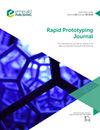Algorithmic detection and categorization of partially attached particles in AM structures: a non-destructive method for the certification of lattice implants
IF 3.6
4区 工程技术
Q1 ENGINEERING, MECHANICAL
引用次数: 0
Abstract
Purpose This paper aims to present a methodology for the detection and categorisation of metal powder particles that are partially attached to additively manufactured lattice structures. It proposes a software algorithm to process micro computed tomography (µCT) image data, thereby providing a systematic and formal basis for the design and certification of powder bed fusion lattice structures, as is required for the certification of medical implants. Design/methodology/approach This paper details the design and development of a software algorithm for the analysis of µCT image data. The algorithm was designed to allow statistical probability of results based on key independent variables. Three data sets with a single unique parameter were input through the algorithm to allow for characterisation and analysis of like data sets. Findings This paper demonstrates the application of the proposed algorithm with three data sets, presenting a detailed visual rendering derived from the input image data, with the partially attached particles highlighted. Histograms for various geometric attributes are output, and a continuous trend between the three different data sets is highlighted based on the single unique parameter. Originality/value This paper presents a novel methodology for non-destructive algorithmic detection and categorisation of partially attached metal powder particles, of which no formal methods exist. This material is available to download as a part of a provided GitHub repository.AM结构中部分附着粒子的算法检测和分类:一种用于晶格植入物认证的非破坏性方法
目的本文旨在提出一种检测和分类部分附着在添加制造的晶格结构上的金属粉末颗粒的方法。它提出了一种处理微计算机断层扫描(µCT)图像数据的软件算法,从而为粉末床融合晶格结构的设计和认证提供了系统和正式的基础,这是医疗植入物认证所需的。设计/方法论/方法本文详细介绍了用于分析µCT图像数据的软件算法的设计和开发。该算法旨在允许基于关键自变量的结果的统计概率。通过算法输入具有单个唯一参数的三个数据集,以便对类似数据集进行表征和分析。发现本文用三个数据集演示了所提出的算法的应用,给出了从输入图像数据导出的详细视觉渲染,并突出显示了部分附着的粒子。输出各种几何属性的直方图,并基于单个唯一参数突出显示三个不同数据集之间的连续趋势。独创性/价值本文提出了一种新的方法来对部分附着的金属粉末颗粒进行无损算法检测和分类,目前还没有正式的方法。此材料可作为GitHub存储库的一部分下载。
本文章由计算机程序翻译,如有差异,请以英文原文为准。
求助全文
约1分钟内获得全文
求助全文
来源期刊

Rapid Prototyping Journal
工程技术-材料科学:综合
CiteScore
8.30
自引率
10.30%
发文量
137
审稿时长
4.6 months
期刊介绍:
Rapid Prototyping Journal concentrates on development in a manufacturing environment but covers applications in other areas, such as medicine and construction. All papers published in this field are scattered over a wide range of international publications, none of which actually specializes in this particular discipline, this journal is a vital resource for anyone involved in additive manufacturing. It draws together important refereed papers on all aspects of AM from distinguished sources all over the world, to give a truly international perspective on this dynamic and exciting area.
-Benchmarking – certification and qualification in AM-
Mass customisation in AM-
Design for AM-
Materials aspects-
Reviews of processes/applications-
CAD and other software aspects-
Enhancement of existing processes-
Integration with design process-
Management implications-
New AM processes-
Novel applications of AM parts-
AM for tooling-
Medical applications-
Reverse engineering in relation to AM-
Additive & Subtractive hybrid manufacturing-
Industrialisation
 求助内容:
求助内容: 应助结果提醒方式:
应助结果提醒方式:


